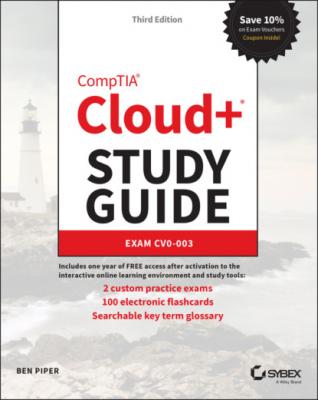CompTIA Cloud+ Study Guide. Ben Piper
Читать онлайн.| Название | CompTIA Cloud+ Study Guide |
|---|---|
| Автор произведения | Ben Piper |
| Жанр | Зарубежная компьютерная литература |
| Серия | |
| Издательство | Зарубежная компьютерная литература |
| Год выпуска | 0 |
| isbn | 9781119810957 |
FIGURE 1.8 IaaS
Platform as a Service
The Platform as a Service (PaaS) model sits somewhere in between the IaaS and SaaS models, and conceptually it is probably the most difficult to grasp because it doesn't have a clear analog in the data center. Essentially, PaaS gives you a preconfigured computing environment on which to install and run the software of your choice. You have little to no control over the configuration of the OS and VMs on which your application runs. NIST describes it thusly:
The capability provided to the consumer is to deploy onto the cloud infrastructure consumer-created or acquired applications created using programming languages and tools supported by the provider. The consumer does not manage or control the underlying cloud infrastructure including network, servers, operating systems, or storage, but has control over the deployed applications and possibly application hosting environment configurations.
A strange but accurate way of saying it is that PaaS offers an operating system as a service on which customers can install their applications, as shown in Figure 1.9. The cloud provider takes responsibility up to and including the operating system, including all hardware and virtualized resources.
FIGURE 1.9 PaaS
Not surprisingly, PaaS is a popular model with software developers because they can deploy their applications quickly without having to mess with provisioning VMs and keeping up with OS maintenance.
Communications as a Service
Communications as a Service (CaaS) is a particular instance of SaaS that includes hosted voice, videoconferencing, instant messaging, email, collaboration, and all other communication services that are hosted in the cloud. These outsourced corporate communication services can support on-premises or mobile users accessing the applications hosted in the cloud.
The CaaS model allows even small to medium-sized businesses to implement advanced technologies at a reasonable metered cost. There is no need for a staff to manage these communication services since the CaaS cloud provider takes responsibility. Another common term for this service is Unified Communications as a Service (UCaaS).
Database as a Service
Database as a Service (DBaaS) is a manifestation of SaaS in which the cloud provider gives you a turnkey database management system on which you can create your own databases. The provider takes care of the hardware and virtual infrastructure, the operating system, and the database software itself. You need concern yourself only with the databases that you create.
Desktop as a Service
Desktop as a Service (DaaS) provides virtual desktops that consumers can access remotely via desktop or laptop computers, mobile devices, or thin clients. This solution is sometimes called virtual desktop infrastructure (VDI). All desktop applications are hosted in the cloud and can consist of any type of application, such as spreadsheets, word processing, and any other common application. You choose what software to install. The DaaS provider manages all maintenance and configurations as well as licensing and version updates. DaaS is an example of the PaaS model.
Business Process as a Service
Business Process as a Service (BPaaS) is a specialized area that outsources many of a company's day-to-day operations such as inventory, shipping, supply chain, finance, and many other services to the cloud. This allows for small and medium-sized businesses to access sometimes very expensive applications from a BPaaS service provider that pools its resources and allows for economies of scale in providing these services. BPaaS is another instance of the SaaS model.
Anything as a Service
Anything as a Service (XaaS) could best be described as offering complete IT services as a package. XaaS is the combination of the services described in this section. It is a broad term that is a catchall of the various service offerings.
Cloud Reference Designs and Delivery Models
The cloud computing industry has created reference designs and delivery models to help differentiate between cloud offerings in the marketplace. By understanding the types of models, you can get the big-picture overview of the overall scope of cloud computing. This section will introduce the cloud models, and then in Chapter 2, I will expand on each one. These are the four primary cloud delivery models:
Public
Private
Community
Hybrid
Public Cloud
The primary focus of the Cloud+ certification is the public cloud, which is the most common delivery model deployed. The public cloud is designed for use by the general public. This is the utility-based pay-as-you-go model. Figure 1.10 illustrates a basic public cloud deployment.
FIGURE 1.10 Public cloud
Private Cloud
A private cloud is for the exclusive use of a single organization, but it may be used by many units or entities inside a company. Figure 1.11 illustrates a basic private cloud deployment.
FIGURE 1.11 Private cloud
Some people have misappropriated the term private cloud to apply to a data center, but this is incorrect. In order to be a private cloud, it has to have the same sort of automation-powered self-service facilities as a public cloud. A traditional data center is not a cloud.
Community Cloud
Community clouds are offered for a specific community of interest and shared by companies with similar requirements for regulatory compliance, security, or policy. Examples include clouds designed for medical, financial, or government organizations that all share common use cases or require standardized architectures. Figure 1.12 shows an example of a common community cloud deployments.
